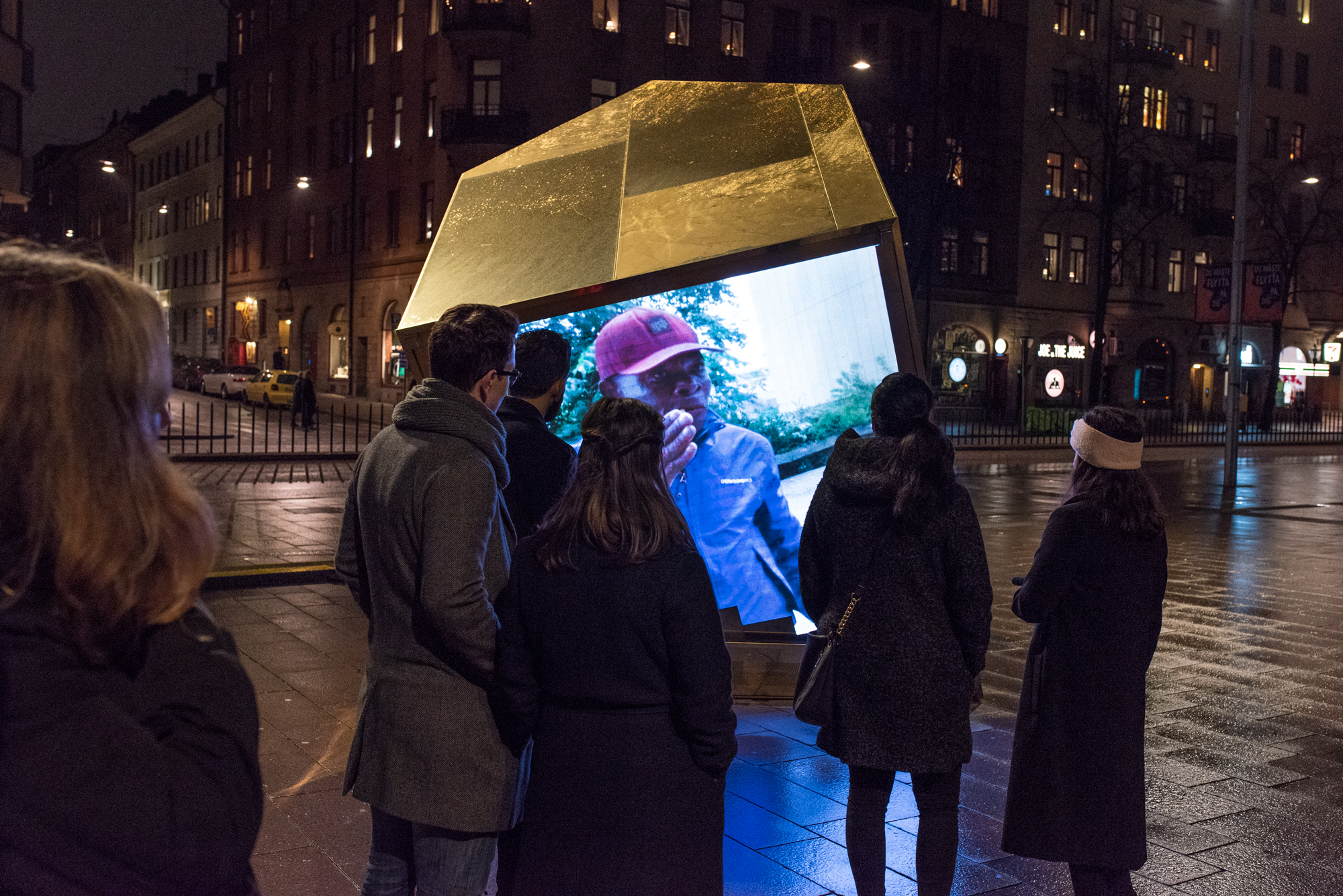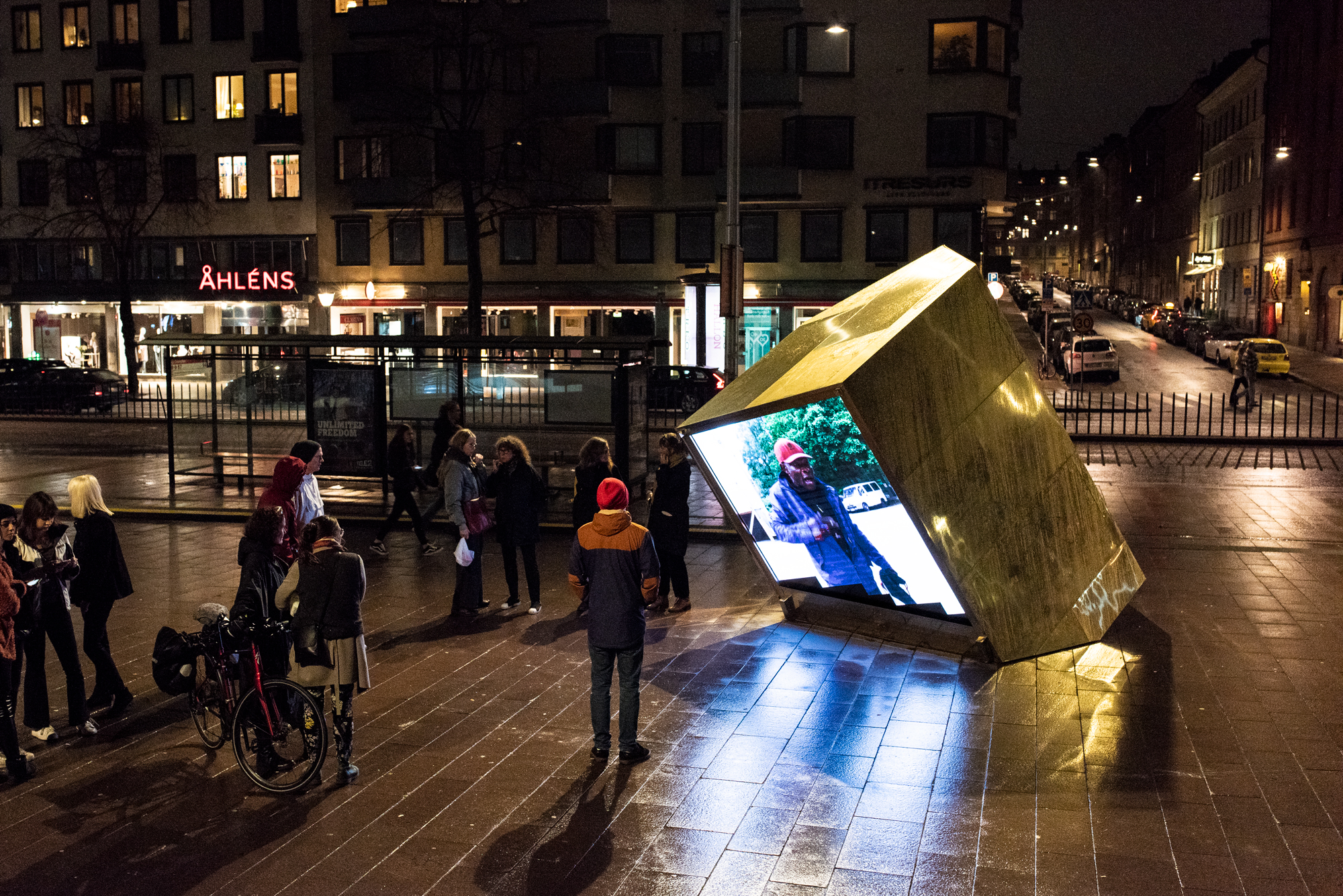A film sculpture for public sites. Watch the film and check for updates on the project site http://aplaceineurope.com/
Norrköping 21/9 – 28/10, Bredgatan 33-34, REMESO, Linsköpings universitet. Inauguration 19:00, 25/9 with Professor Stefan Jonsson.




 Fotografier: Cecilia Parsberg
Fotografier: Cecilia Parsberg
Photos above: 8–15 november 2018, Odenplan, Stockholm.
(Find synopsis in English below)
The artwork depicts in a forceful way how migration and fundamental human rights are influenced by global politics. The powerful form of the work gathers its strength from the sophisticated simple architectural form and the film’s captivating documentary content. A brutal reality creates an explosive foundation for a work of art that reflects contemporary issues in society and reveals cracks its construction (Liljevalchs Konsthall, Stockholm)
Konstnärerna Erik Pauser och Cecilia Parsberg har tillsammans med arkitekterna Haval Murad och David Martinez Escobar skapat en konstnärlig gestaltning som speglar sprickor i det moderna samhället. Filmskulpturen startade sin resa under en vecka på Odenplan för att fortsätta på andra offentliga platser i storstäder. Skulpturen har form av ett hus som vält. Undersidan består av en LED-skärm där kortfilmen En plats i Europa projiceras. Den handlar om en undanskymd plats i en storstad. En plats som har blivit ett hem för arbetssökande migranter, som fallit mellan stolarna i den europeiska fria rörligheten. Berättaren är Thomas som under tre år har haft sin sovplats under en lastbrygga. Nu ska han vräkas. Han representerar de som vill göra rätt för sig: arbeta, försörja sin familj, leva ett värdigt liv.
På ett drabbande sätt fångar konstverket viktiga frågor kring migration och grundläggande mänskliga rättigheter som påverkas av den globala politiken. Beror en människas utsatthet på individens eller samhällens misslyckanden? Verkets kraftfulla formspråk hämtar sin styrka i den sofistikerat enkla arkitektoniska formen och filmens gripande, dokumentära innehåll. En brutal verklighet är här ett sprängstoff för konsten som speglar samhällsaktuella ämnen och synliggör sprickor i sociala konstruktioner. Det är konsten som bränner till och som aldrig vänder blicken från de mest komplexa frågorna.
Filmen En plats i Europaav Cecilia Parsberg och Erik Pauser ingår i dokumentärserien RÖST, en satsning av Svenska Filminstitutet, SVT och Folkets Bio. Produktionen har fått stöd av Konstnärsnämnden och Kulturbryggan. Den har bland annat visats i Almedalen, på skolbio och filmfestivaler i Sverige och internationellt.
Cecilia Parsberg, född 1963, är konstnär och filosofie doktor i Fri konst. Hennes avhandling Hur blir du en framgångsrik tiggare i Sverige (2016), som består av texter, bilder och filmer, ställer frågor kring hur de tiggande människorna och givarna ingår i en social interaktion och hur de relaterar till varandra. Parsbergs skapande kretsar kring angelägna sociala, politiska och existentiella frågor och undersöker brännpunkter i samhällen. Hennes konst har visats på Moderna Museet och Nationalmuseum i Stockholm, Tate i London med flera.
Erik Pauser, född 1957, är filmskapare, producent och konstnär. Pausers dokumentärfilmer skildrar ofta samhällsfrågor. Han har gjort flera filmer om krig och dess konsekvenser. Hans sista dokumentär The Borneo Case har visats i mer än 50 länder. Hans filminstallationer har visats på museer och gallerier i Sverige och utomlands. Filmerna har vunnit en rad priser på internationella filmfestivaler.
Haval Murad, född 1983, är byggingenjör och arkitekt utbildad vid Kungliga Tekniska Högskolan. Han är grundare till arkitektkontoret Detail Group som arbetar med hållbar stadsutveckling ur ett tvärdisciplinärt perspektiv. Murad’s arbete spänner sig över ett brett fält och berör frågor i gränslandet mellan arkitektur, konstnärskap, politik och samhällsutveckling.
David Martinez Escobar, född 1983, är arkitekt utbildad i Mexiko och Sverige. Martinez har specialiserat sig i Design for Sustainable Developmentpå Chalmers Tekniska Högskola. Han är partner på arkitektkontoret Detail Group och har under sina 10 års som arkitekt fokuserat på hållbarhetsfrågor inom samhällsutvecklingen och rollen som arkitekt.
KontaktLiljevalchs: Mårten Castenfors, chef Liljevalchs. marten.castenfors@stockholm.se, 08–505 31 332
Projektet är gjort med stöd från: Kulturbryggan, Konstnärsnämnden, Liljevalchs/Stockholm Konst, Detail Group
English:
The project name ”A Place in Europe” is an umbrella for: a film sculpture titled ”The House” (première during the fall 2018) and a short film (première June 2018 in RÖST). The presentations in Stockholm are orchestrated by Liljevalchs Konsthall and Stockholm Konst, including seminars/arranged talks. Our aim is also to engage other EU countries.
Synopsis of the Film: In an undisclosed place in central Stockholm a sort of state of exception seems to be in effect. During night time job seekers from different parts of the world live here.
Daytime they share the place with workers, building the new Stockholm. Watch the film.
Idea and implementation
In an innovative and surprising way, we want to participate in the discussion on migration and human rights. We want to include and visualize a place and a life situation that many migrants have – and, as we mean, is becoming more common in Europe, but is often hidden from the public.
A mobile film sculpture with the shape of a house dives into the ground. The House will be presented on thirty public places in Sweden and Europe. The House is transported by truck and installed in a public space in the city for 1-7 days. In connection with this, different types of public conversations, workshops and theme days are organized. The bottom of the House consists of a 2.5m wide LED screen where a short film is displayed. (The screen works well in daylight. Built in the House there is an audio system). The film is also shown as part of the short film program RÖST (Voice) — Swedish Filminstitute and Swedish Television has invited established directors and new filmmakers to make short films to inspire political commitment, intitate discussions about democracy and make us vote. This year, Sweden is celebrating 100 years of democracy. The film is also on YT channels of Swedish Television and shown in schools and cinemas by Folkets Bio.
Work process
We have been filming in an area in central Stockholm; bordered by a highway on one side, a subway line on the other and a forest on the third, almost invisible to those passing bywhere a kind of state of emergency seems to prevail. Here, a group of people of different nationalities lives and works temporarily, they have ”fallen between the chairs” in the EU system. It is one of the many places in Europe that is becoming more common, but it is still a place we rarely see. Tomas, a well-dressed man, has slept here under a concrete loading dock together with the rats. Now he’s going to be evicted.
Tomas is upset and defends his rights as a human being.After eighteen years of work at a factory in Italy he became unemployed. Without a social safety net, he is now living on the street and owns nothing. Thomas’s speech is drastic. In a straightforward way he explains his situation. He wants to live an honest life and support his family, but it seems impossible. He urges society to bring him in court so that he can defend himself and get justice. Thomas is at the same time giving voice for others in the same situation.
The House dives into the ground, people fall with the house, the boats on the Mediterranean are unable to carry people, the Swedish regulations or the EU’s regulatory system can’t uphold immigrants who come here via the Free movement of Persons.[1]
Artist’s intention and rationale
We believe that art can make visible and open up for constructive conversations. Therefore, the project, apart from the House and the short film, also includes stories from the audience, seminars and other forms of open conversation with participants from different fields of knowledge and backgrounds, linking home, homelessness, migration and human rights. Everyone has stories, thoughts and experiences about home and homelessness and can contribute, in some way, to collective thinking about this complex social problem.
Presenting the House in public places, we will also reach those who usually don´t see art and documentary films and don’t participate in the discussion about the EU or people’s movement across international borders. Planned events with invited guests aim to initiate meetings between groups that rarely speak. An important target group is young people and The House could for example be displayed on a schoolyard. In conjunction with this theme days at the school can be arranged.
We are convinced that the experience the audience gets through the project can become a seed for future engagement at different levels.
 The House at Odenplan, Stockholm. Film screening on a LED screen. The House is covered with brass sheet. The film-sculpture is a collaboration between: Cecilia Parsberg, Erik Pauser and the architects David Martinez Escobar and Haval Murad from Detail Group. (Photos by Cecilia Parsberg.)
The House at Odenplan, Stockholm. Film screening on a LED screen. The House is covered with brass sheet. The film-sculpture is a collaboration between: Cecilia Parsberg, Erik Pauser and the architects David Martinez Escobar and Haval Murad from Detail Group. (Photos by Cecilia Parsberg.)
Contact:
Cecilia Parsberg
The project has research status and has been peer reviewed by four professors at four different universities through the International Research Project Project Anywhere (about).
A Place in Europe received the highest score for innovative methodology at Kulturbryggan 2016 and a start grant. The project also received a project grant 2017-18 from The Swedish Arts Grants Comittee.
[1]Freedom of movement and residence for persons in the EU is the cornerstone of Union citizenship, established by the Treaty of Maastricht in 1992. http://www.europarl.europa.eu/atyourservice/en/displayFtu.html?ftuId=FTU_4.1.3.html
Lives that have been separated – by an imagined structure – can also be connected – by a lived structure – but not without hope of something else.
